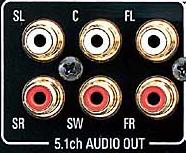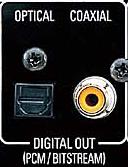
Remember the days when connecting your turntable, 8-track, and tape player all used the same two cables? For years connecting audio to a receiver was a snap because there was only one way to do it. Well... those days are gone. Digital technologies have expanded the number of different connections capable of carrying audio to a receiver. While many devices are fairly self-explanatory, DVD players can boggle a consumers mind by offering, in come cases, five or more different choices to connect to a receiver.
There are many myths about which connections are better than another, and should therefore be used to provide the best audio quality. Welcome to the truth, which may be surprising to those that have relied on the misinformation that seems to plague the electronics industry.
First off, below are the common types of audio outputs found on DVD players today. A DVD player will have at least two of these, and some may have more.
- Stereo - Red/white RCA jacks. This will be present on every DVD player
- Optical Digital - black plastic jack often fitted with a black plug.
- Coaxial Digital - Orange RCA plug. Sometimes labeled as SPDIF
- Analog Multi-channel - Six to eight RCA jacks labeled L, R, RS, LS, C, SW, etc.
- HDMI - HDMI connections can carry both audio and video.
Some players may have proprietary audio jacks that connect only to select receivers by a manufacturer. For example, top-end Denon products may be outfitted with a "Denon Digital Link" connector, which connects the DVD player to the receiver using a CAT5 network cable. It is recommended to use these connections if both components are the same brand, and are equipped with the proper connection.
Figuring Out Which Connection to Use
The next step in determining which audio connection to use is to examine the available options on the receiver. Discard any choice not available on the home theater receiver. Older Dolby Pro-Logic and stereo-only receivers will not have digital connections.
Analog Multi-channel
 Analog multi-channel out can provide higher audio fidelity than digital connections in certain systems. Digital signals must be decoded at one end or another. If a digital connection is used, the receiver must be capable of decoding the desired signal. Analog connections are decoded in the player.
Analog multi-channel out can provide higher audio fidelity than digital connections in certain systems. Digital signals must be decoded at one end or another. If a digital connection is used, the receiver must be capable of decoding the desired signal. Analog connections are decoded in the player.
If connecting a player capable of playing DVD-Audio or SACD discs, the decoder for these formats is built into the player. Players of this type must be connected with the analog multi-channel output for the performance to be realized. Many users will use a digital connection in conjunction with this output, depending on the behavior of the receiver.
When connecting to an older "Dolby Digital Ready" receiver. These receivers do not have a built-in digital decoder. It provides a multi-channel input for an external digital decoder. It is the only way to experience multi-channel sound on a receiver of this kind.
All digital to analog (D/A) converters have certain characteristics that will color the audio. High-end DVD players will have superior D/A converters than what is used in mid to low end receivers. Audiophiles will choose their connection based on which device has the superior D/A converter.
HDMI
 Some DVD players are capable of sending a digital audio and video down one HDMI cable. There may be some high-end receivers that switch HDMI and pull audio at the receiver before passing video to the TV, but HDMI cables will normally be plugged into a television. HDMI enabled TVs will provide an optical or coaxial digital connection that will carry the audio to a home theater receiver. For surround sound users, this connection is not currently an end-to-end solution.
Some DVD players are capable of sending a digital audio and video down one HDMI cable. There may be some high-end receivers that switch HDMI and pull audio at the receiver before passing video to the TV, but HDMI cables will normally be plugged into a television. HDMI enabled TVs will provide an optical or coaxial digital connection that will carry the audio to a home theater receiver. For surround sound users, this connection is not currently an end-to-end solution.
Coaxial and Optical Digital Connections
 Coaxial and optical digital connections are the most common connection used to transfer audio to a digital capable receiver. Most digital capable receivers should support both of these connection types, though some DVD players only have one or the other.
Coaxial and optical digital connections are the most common connection used to transfer audio to a digital capable receiver. Most digital capable receivers should support both of these connection types, though some DVD players only have one or the other.
There is an ongoing, no-win debate over which connection sounds better. In reality, only the most advanced ear would be able to discern any difference between the two. It is believed that coaxial connections will sound better at shorter distances, but again, we're splitting hairs. Use whichever connection leaves one of each type open, if possible. That way a later purchased device that only has one type can be easily added.
Stereo
 Stereo connections should be used on equipment lacking digital capabilities. Though one exception is DVD players that contain an HDCD decoder, which can give compatible CDs a boost in audio quality. However, a digital connection should still be made for movie listening.
Stereo connections should be used on equipment lacking digital capabilities. Though one exception is DVD players that contain an HDCD decoder, which can give compatible CDs a boost in audio quality. However, a digital connection should still be made for movie listening.
Stereo connections are also handy for connecting secondary listening equipment like wireless headphone, multi-zone controllers, and analog recording devices. DVD players usually output sound out of digital and analog jacks simultaneously; therefore there will be no need to switch cables.
Summary
As digital technologies evolve, it is hoped that the variety of connections will someday be replaced by a single standard. It may even be possible that all devices can interoperate with each other using a single cable connected to each device. Only time will tell...





Comments
How do I connect a dvd player
How do I connect a dvd player to my pioneer receiver?
HELLO NEED YOUR HELP, ADVICE.
HELLO NEED YOUR HELP, ADVICE. HOW DO I CONNECT MY PANASONIC DVD/CD PLAYER >DVD-RV32 TO MY YAMAHA RECEIVER STEREO. HAVING PROBLEMS NOT TO PLAY & NO SOUND .NO AUDIO AT ALL. THANKS LET ME KNOW. DON'T HAVE MANUAL FOR THE UNIT HAVE A UNIVERSAL CONTROL
FOR THE RECEIVER.